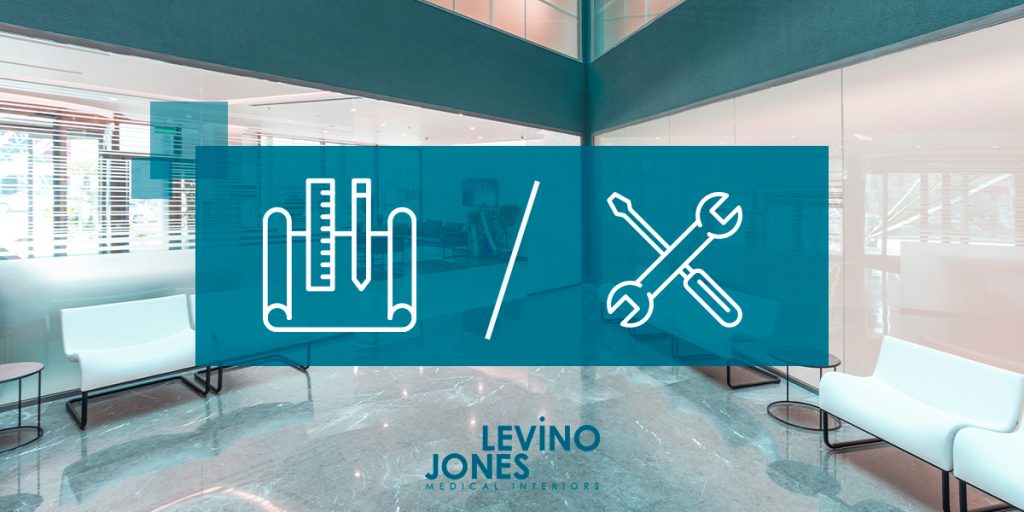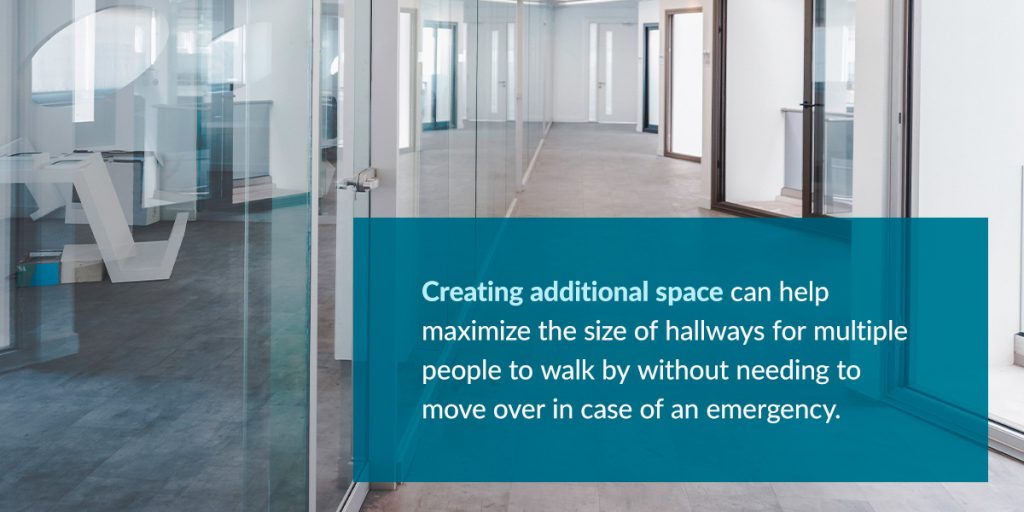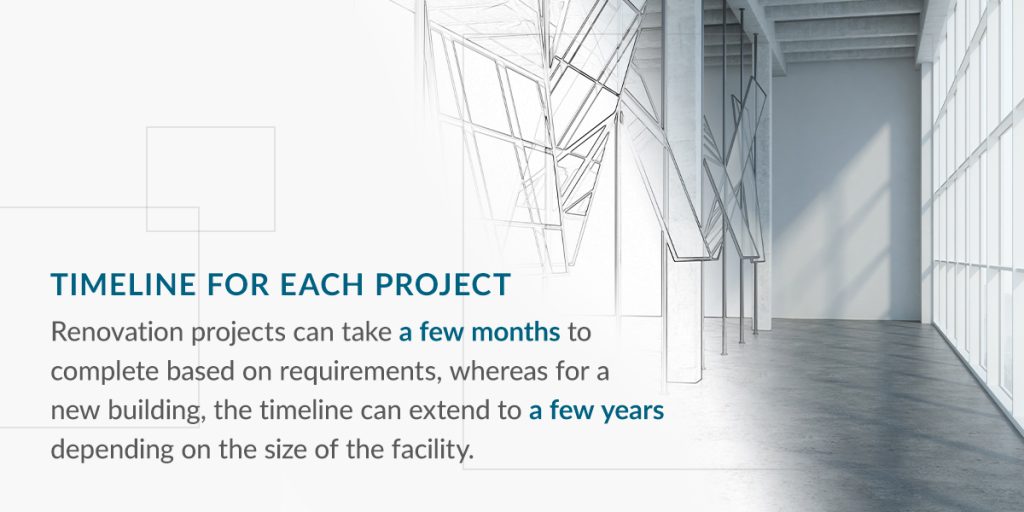
Being a part of the medical field is an admirable profession as you work around-the-clock to save lives and provide hope for families. You offer quality services daily to patients of all backgrounds, but the visual aesthetic of your practice most likely does not cross your mind. However, remodeling or creating a new space for patients receiving treatment during appointments can change their whole experience.
Whether you work in a larger healthcare facility or privately-owned medical office, you can determine what is best for your space: renovating your existing space or moving to a new building that you have the option to redesign. Take some time to explore the pros and cons of each option before creating a brand new look for your medical space.
The place that you administer your practice each day has become incredibly familiar to you and your patients. You may not even notice the need to change the look of this space. However, even the slightest design modification can create a different atmosphere that makes your daily routine feel fresh.
By remodeling or relocating, you have the opportunity to make your practice your own by incorporating your aesthetic into your office. You can also take this time to design the rooms to make patients more comfortable. A medical office or hospital’s typical whites and blues can leave some individuals on edge as they enter the facilities. You can use different colors, modern architectural accents or carefree design tactics to make them feel more comfortable in a professional environment.
If you are on the fence about remodeling or moving your place of practice, there are a few ways to incorporate different scenarios into your final decision. Both possibilities benefit you, your staff and patients through design changes to your place of work.
Remodeling your current space or moving the location where you care for patients can provide numerous benefits for them and your practice. You can take the opportunity when renovating to expand your practice to meet the medical needs of local individuals.
If your establishment offers a wide variety of services, consider adding even more. Whether your patients could benefit from a more comprehensive selection of treatment options, more doctors to provide professional opinions for their condition or new technology to fit modern medicinal practices, expanding can grow your audience.
When you can cater to more people in the area, you can expect your facility or office to become well known over time. You might notice higher recommendations from loyal patients to attract the attention of new individuals seeking treatment.

Medical facilities and offices can sometimes become crowded with patients, staff and equipment. Creating additional space can help maximize the size of hallways for multiple people to walk by without needing to turn or move over in case of an emergency. You could more safely move from room to room without bumping into someone else and disrupting your routine. This extra space can also allow for more frequent appointment times, so each day goes by smoother with fewer interruptions.
This option also provides patients with more comfortable treatment conditions. Those staying overnight or for multiple days may find themselves more at ease with additional space for privacy.
Remodeling projects can keep the same area for lobbies and patient rooms and redesign them to feel more spacious. Allowing more space for patients decreases the spreading of diseases and other safety concerns resulting from tight quarters in medical practice.
Choosing between renovating or replacing your medical office is a big decision. Before contacting a trusted team of contractors and designers, it is crucial to consider a few factors that could impact a construction project and know what to expect in each scenario.
The cost of renovating or moving locations can differ depending on the timing of construction. Those that remodel their current space may choose to close the office for a few weeks or ask the contractors to renovate the space in segments at a time. Most think that the most cost-efficient way to run their practice while renovating is to extend the timeline so some rooms are under construction while patients take up the other spaces. However, this choice can actually cost more and disrupts your work day.
However, if you work in a larger facility that requires intense renovations to provide for the safety of patients and staff, it would be beneficial to invest in a completely new building project. This option ensures that all new medical spaces will uphold for decades, whereas renovations will only last as long as the rest of the building.
Cost efficiency is essential for large projects such as these. Research the age and repair needs of your place of practice to determine which approach is best for you, your staff and your workspaces.
The construction timeline for moving locations or building a new facility from scratch can also influence costs. These options take a few months to years to complete but you will not have to close your current practice or face disruptions as the process takes place.
Your practice is essential for your staff, patients and yourself. Taking the time to complete a renovation or replacement can leave you on edge as you strive to return to your daily routine. This factor is significant when deciding which project to embark on to benefit all three parties.
For either project, the designing process can take some time to complete. The team you work with will need to inspect the existing space to assess the desired changes. This opportunity is perfect for you to ask questions about budgets, timelines and what the requirements are on your part. You can establish the design ideas you wish to incorporate into your office or facility.
Renovation projects take a few months to complete based on the requirements you set with the contractors. In most cases, remodeling usually means replacing floors, paint colors, wall decor and the interior layout of a few rooms. With the additional time from creating the design plans, renovation should not take longer than a year to wrap up. During this time, most physicians take a few months before seeing patients again because of the disruption.
For a new building, the timeline can extend to a few years, depending on the size of the facility. During this time, construction teams will tear down the existing building, establish a new foundation to support the facility and plan the layout for new rooms for the whole building. Some physicians choose to practice from a different location while the construction takes place to ensure their patients are cared for without interruption.

Your medical office or hospital can benefit from a remodel or a new build depending on its current age, structure and services provided within the building.
The pros and cons of renovating a medical office or hospital depend heavily on budgets and timelines that contractors set in place after the design process concludes. These factors are vital for staff members as they can cut into the time they use to work with patients. Before making any final decisions, consider the following advantages and disadvantages of renovating or replacing your healthcare workspace.
The benefits of renovating healthcare facilities can significantly influence your average work routine as the new changes provide a unique atmosphere for you, your staff and patients. Whether you have your own medical office or work in a larger hospital, remodeling can make your space more accessible and fit every patient’s needs without burning a hole in your wallet.
Modern renovations implement different flooring styles such as vinyl and laminate planks and tiles. These options help prevent infections since the material does not absorb moisture or other elements in the air. Your space can benefit from this improvement in overall cleanliness while ensuring the health of your patients.
Renovating saves you a significant amount of money. Instead of tearing down the building and starting from scratch, you can enhance specific areas of your practice that need renovations or a visual change. You can incorporate your aesthetic into these spaces to benefit you, your staff and the patients without costing you too much upfront.
Remodeling projects also take less time than building. Renovation does not require rezoning the current property, so the project should only take a few weeks to a couple of months. You can get back to your daily routine as quickly as possible with a remodel so your patients do not have to reschedule appointments too far in advance.
While you may have plans to redecorate your place of practice completely, a remodeling project allows you to maintain a sense of familiarity with the rooms where you offer quality services to your patients. Those that visit the facilities for scheduled appointments can also recognize the layout of the rooms they frequently use while enjoying a new atmosphere.
While remodeling projects can take less time and save money on construction expenses, there are also a few disadvantages to consider before making a final decision.
You will have the opportunity to update the space as you see fit. However, you have limited freedom to completely transform the area based on budget constraints and the overall size of the building. However, if you feel the rooms are too small or need a more open concept, you can choose to knock down walls and change the room-to-room ratios. You will need to work around the current structure of the preexisting rooms. On the other hand, some physicians prefer this limitation, so they only need to input their decisions into the room’s design rather than the entire building.
While renovations take weeks or months, treating patients without a fully functioning facility can be challenging. You and your staff will most likely need to work around the construction happening around the building, which can cause disruptions to your standard work day. You may also be working at a temporary location that could be out of the way for your patients.
Tearing down your workplace and starting fresh can provide numerous benefits for you, your coworkers and the patients that visit the premises each day.

One of the most significant advantages of a new medical office and healthcare facility is the opportunity to install new or updated features that keep patients, staff and doctors as safe as possible. Furniture, wallpaper and floors can be home to various germs that can seep into out-of-reach places after years of medical practice.
Long-term care facilities, outpatient care and acute hospitals can spread diseases such as pneumonia, Clostridium difficile and bloodstream infections from bacteria in the environment. To enhance the safety of everyone who passes through your building, you can establish new features and safety precautions after moving to a new location.
Moving gives you the opportunity to effectively decrease the spreading of germs by:
One of the greatest aspects of moving locations is the opportunity to expand your practice. While a renovation can also include expansion to fit more staff and medical equipment, a new building makes it easier to find the right space to accommodate your future plans without needing to add extra rooms to your facility.
Moving allows you to think of new additions to your current medical workspace that you want to incorporate into your practice. Patient treatment and satisfaction is the top priority for medical staff. To improve these statistics with each visit, you can brainstorm how a larger waiting room, larger spaces for individuals with limited mobility or bigger patient rooms can significantly improve their stay.
A more accessible environment that accommodates their every need can significantly boost your workplace’s morale among guests and staff. You will also have the opportunity to allow more space to work, which can make your average workday more comfortable as you provide quality medical care to each patient.
Starting your new facility from scratch gives you full access to redesign the space as you see fit. You know your patients more than anyone. You can instruct contractors, designers or painters to add certain architectural aspects to various rooms to satisfy your patients with each visit.
You can also provide them with details for your own needs, such as creating a new office space for you and your coworkers to make each day more enjoyable and comfortable. Your creative freedom is unlimited with a completely new building.
Similar to remodeling projects, moving also comes with a few disadvantages to consider before deciding on your building’s redesign.
The total cost is one of the biggest influences on renovating vs. building or moving to a new hospital or another healthcare facility. Shifting to new offices and facilities will cost significantly more than remodeling projects. While there are numerous advantages to moving to a larger healthcare space, it is essential to go over your budget before choosing this option. Contractors’ timing and materials to make this new space come to life can increase the project’s final price.
The timeline for a complete relocation can span multiple years. The size of the building or tenant space and the complexity of creating a brand new architectural redesign plan can lengthen the completion date. During this time, you can still see patients at your current location or opt to see patients at a temporary location nearby, so you will not have to lose revenue or patient loyalty.
Depending on the state of your workspace, you may need to obtain a Certificate of Need to begin building a new facility or medical office. This certificate grants you the ability to establish new locations or expand your current healthcare practice. This step may increase the timeline of your project since this is the first step to starting the rebuilding process, should you choose to relocate from scratch.
Are you ready to start your renovation, or are you still unsure what’s the best fit? Speak with our expert designers at LeVino Jones Medical Interiors in a consultation. Whether you are considering an interior design remodel project or a complete relocation for your medical workspace, you can trust LeVino Jones to help make your expectations a reality.
During our design process, you can be a part of every step to ensure you are satisfied with the layout while saving you time and money. We can help take care of all the details such as lighting, cabinetry and power so you can focus on providing quality care for your patients.
Contact us today to start designing the perfect space for you and your patients.